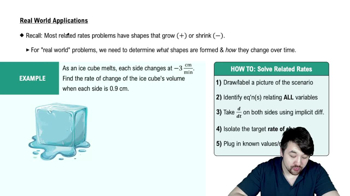Table of contents
- 0. Functions7h 52m
- Introduction to Functions16m
- Piecewise Functions10m
- Properties of Functions9m
- Common Functions1h 8m
- Transformations5m
- Combining Functions27m
- Exponent rules32m
- Exponential Functions28m
- Logarithmic Functions24m
- Properties of Logarithms34m
- Exponential & Logarithmic Equations35m
- Introduction to Trigonometric Functions38m
- Graphs of Trigonometric Functions44m
- Trigonometric Identities47m
- Inverse Trigonometric Functions48m
- 1. Limits and Continuity2h 2m
- 2. Intro to Derivatives1h 33m
- 3. Techniques of Differentiation3h 18m
- 4. Applications of Derivatives2h 38m
- 5. Graphical Applications of Derivatives6h 2m
- 6. Derivatives of Inverse, Exponential, & Logarithmic Functions2h 37m
- 7. Antiderivatives & Indefinite Integrals1h 26m
- 8. Definite Integrals4h 44m
- 9. Graphical Applications of Integrals2h 27m
- 10. Physics Applications of Integrals 2h 22m
4. Applications of Derivatives
Related Rates
Problem 3.6.7
Textbook Question
Define the acceleration of an object moving in a straight line.
 Verified step by step guidance
Verified step by step guidance1
Acceleration is defined as the rate of change of velocity of an object with respect to time. It is a vector quantity, meaning it has both magnitude and direction.
To find the acceleration, you need to know the velocity function of the object, which is typically given as v(t), where t represents time.
The acceleration a(t) can be found by taking the derivative of the velocity function v(t) with respect to time t. This is expressed mathematically as: <math xmlns="http://www.w3.org/1998/Math/MathML"><mrow><mi>a</mi><mo>(</mo><mi>t</mi><mo>)</mo><mo>=</mo><mfrac><mrow><mi>d</mi><mi>v</mi><mo>(</mo><mi>t</mi><mo>)</mo></mrow><mrow><mi>d</mi><mi>t</mi></mrow></mfrac></mrow></math>
If the velocity function v(t) is given, apply the rules of differentiation to find the derivative. This involves using techniques such as the power rule, product rule, or chain rule, depending on the form of v(t).
Once you have calculated the derivative, you have the acceleration function a(t), which describes how the velocity of the object changes over time.
 Verified video answer for a similar problem:
Verified video answer for a similar problem:This video solution was recommended by our tutors as helpful for the problem above
Video duration:
2mPlay a video:
Was this helpful?
Key Concepts
Here are the essential concepts you must grasp in order to answer the question correctly.
Acceleration
Acceleration is defined as the rate of change of velocity of an object with respect to time. It indicates how quickly an object is speeding up or slowing down. Mathematically, it is expressed as the derivative of velocity with respect to time, and it can be positive (indicating an increase in speed) or negative (indicating a decrease in speed).
Recommended video:

Derivatives Applied To Acceleration
Velocity
Velocity is a vector quantity that describes the rate at which an object changes its position. It includes both the speed of the object and the direction of its motion. Understanding velocity is crucial for calculating acceleration, as acceleration is derived from changes in velocity over time.
Recommended video:

Derivatives Applied To Velocity
Kinematics
Kinematics is the branch of mechanics that deals with the motion of objects without considering the forces that cause the motion. It provides the foundational equations and concepts, such as displacement, velocity, and acceleration, which are essential for analyzing the motion of objects in a straight line.
Related Videos
Related Practice






